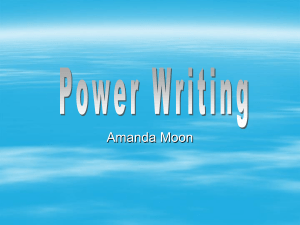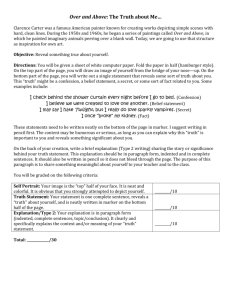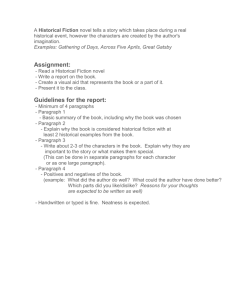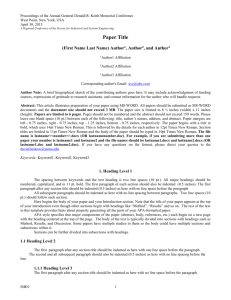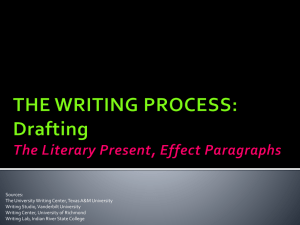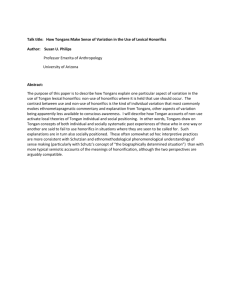Submissions for ECP 2015 Proceedings
advertisement
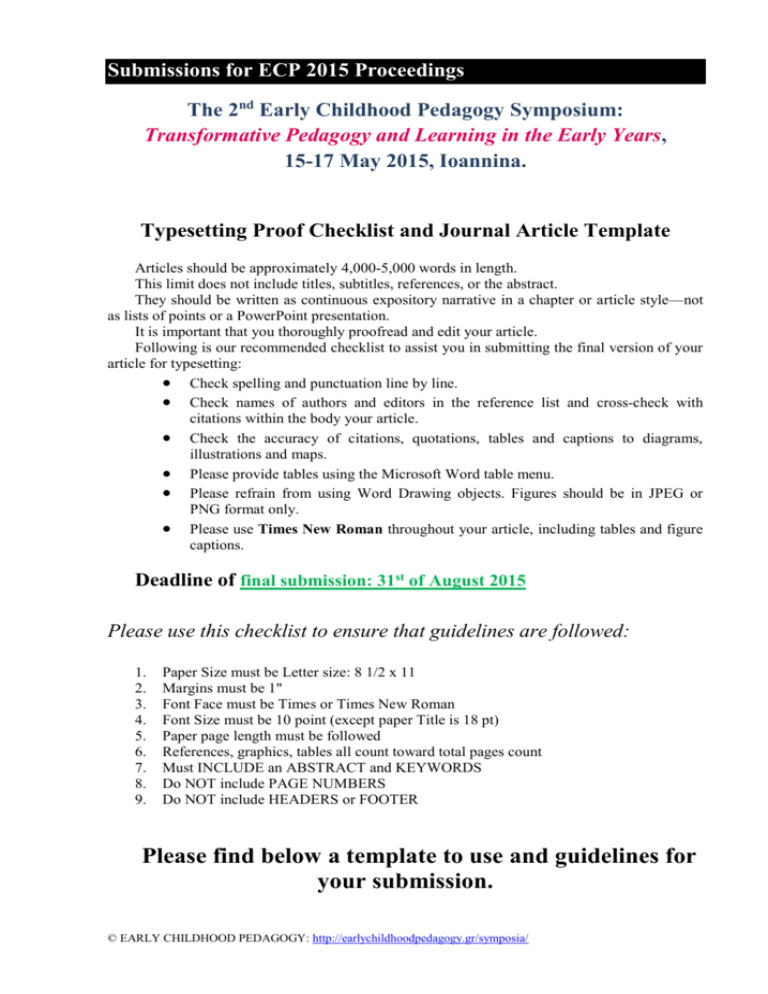
Submissions for ECP 2015 Proceedings The 2nd Early Childhood Pedagogy Symposium: Transformative Pedagogy and Learning in the Early Years, 15-17 May 2015, Ioannina. Typesetting Proof Checklist and Journal Article Template Articles should be approximately 4,000-5,000 words in length. This limit does not include titles, subtitles, references, or the abstract. They should be written as continuous expository narrative in a chapter or article style—not as lists of points or a PowerPoint presentation. It is important that you thoroughly proofread and edit your article. Following is our recommended checklist to assist you in submitting the final version of your article for typesetting: Check spelling and punctuation line by line. Check names of authors and editors in the reference list and cross-check with citations within the body your article. Check the accuracy of citations, quotations, tables and captions to diagrams, illustrations and maps. Please provide tables using the Microsoft Word table menu. Please refrain from using Word Drawing objects. Figures should be in JPEG or PNG format only. Please use Times New Roman throughout your article, including tables and figure captions. Deadline of final submission: 31st of August 2015 Please use this checklist to ensure that guidelines are followed: 1. 2. 3. 4. 5. 6. 7. 8. 9. Paper Size must be Letter size: 8 1/2 x 11 Margins must be 1" Font Face must be Times or Times New Roman Font Size must be 10 point (except paper Title is 18 pt) Paper page length must be followed References, graphics, tables all count toward total pages count Must INCLUDE an ABSTRACT and KEYWORDS Do NOT include PAGE NUMBERS Do NOT include HEADERS or FOOTER Please find below a template to use and guidelines for your submission. © EARLY CHILDHOOD PEDAGOGY: http://earlychildhoodpedagogy.gr/symposia/ ECP Proceedings Journal Article Title: Subtitle Author Name, University Affiliation, Country Abstract: Please insert the abstract here. To denote italicization in the abstract or keywords, please use double quotation marks. An example would be “The International Journal of the Book.” Keywords: List of Keywords in Title Case, Commas in between, Keywords Should be Center Aligned Section Heading T he opening paragraph has no indentation. The first letter of the opening paragraph of the article should be in drop case. Your article’s format should follow the format of this template. To use the template, use the original Style Set that we have created for you, which you have downloaded by opening this sample template. The Style Set can be found in the upper right hand corner of the page under the tab “Home” and is listed as “Styles.” If you are using a separate Microsoft document than this one, please first save this style set to your computer by clicking on “Change Styles,” “Style Set,” and then “Save as a Quick Style Set.” Name the style set anything that you like (for example “CGJournalArticleStyleSet”) and then you will be able to access this style set from other Microsoft documents. To access the style set that you saved, click “Change Styles,” “Style Set,” and click on the set that you just saved. To determine which style is used in each section, click on the text in that section. For example, this section is using the “FirstParaOfSectionTextStyle.” Highlight the text that you would like to be formatted, and click on the corresponding Style, and the text will be changed automatically to format according to the style that you press. Please do not alter the margins; they are customized to fit the layout of our typesetting software and are different on odd and even pages for printing reasons. Information in the footer will be updated when the article is typeset. Block quotations should be indented by .5 inches, should not include quotation marks, and should end with a parenthetical citation after the period. Block quotes should be used when quoting five or more lines. (Author Surname year published, page number when available) The second and subsequent paragraphs in sections are indented by .25 inches. Text should be single spaced, and spaces should only exist between paragraphs when using block quotes, as seen above. New Section Heading The opening paragraph has no indentation. 1 The second and subsequent paragraphs in sections are indented by .25 inches. Section Subheading The opening paragraph has no indentation. The second and subsequent paragraphs in sections are indented by .25 inches. 1 While we highly encourage internal author-date citations, if you are using the footnote system, please make sure to use the footnote function on Microsoft Word (found under the references section) and to keep footnotes in size 8 font in Times New Roman. AUTHOR SURNAME: ARTICLE TITLE Section Subheading 2 The opening paragraph has no indentation. The second and subsequent paragraphs in sections are indented by .25 inches. When inserting tables and figures within the body of the article, position them after the paragraph in which they are described. When citing the source information, it should be included at the bottom of the figure in a “source line.” Tables and figures should be labeled with numbers and a short, descriptive title. Table headings should be centered above the table, while figure captions should be centered below the image. Examples can be seen below in Table 1.1 and Figure 1. Table 1.1: Title of Table Column Title Column Title Column Title Row Title Row Title Source(s): Data Adapted from Author’s Surname year of publication. Figure 1: Caption of Figure Here Source(s): Author’s Surname year of publication. Another Section Heading The opening paragraph has no indentation. 2 The second and subsequent paragraphs in sections are indented by .25 inches. Follow the same format as above for the rest of your journal article. 2 While we highly encourage internal author-date citations, if you are using the footnote system, please make sure to use the footnote function on Microsoft Word (found under the references section) and to keep footnotes in size 8 font in Times New Roman. ECP Proceedings REFERENCES Insert reference list here. It should follow the APA system . ABOUT THE AUTHORS Author Name: Insert author biography here. For multiple authors, follow the same format. Honorifics can be included in this section. Please do not include honorifics on the first page of the journal article. Author Name: Insert author biography here. For multiple authors, follow the same format. Honorifics can be included in this section. Please do not include honorifics on the first page of the journal article.

